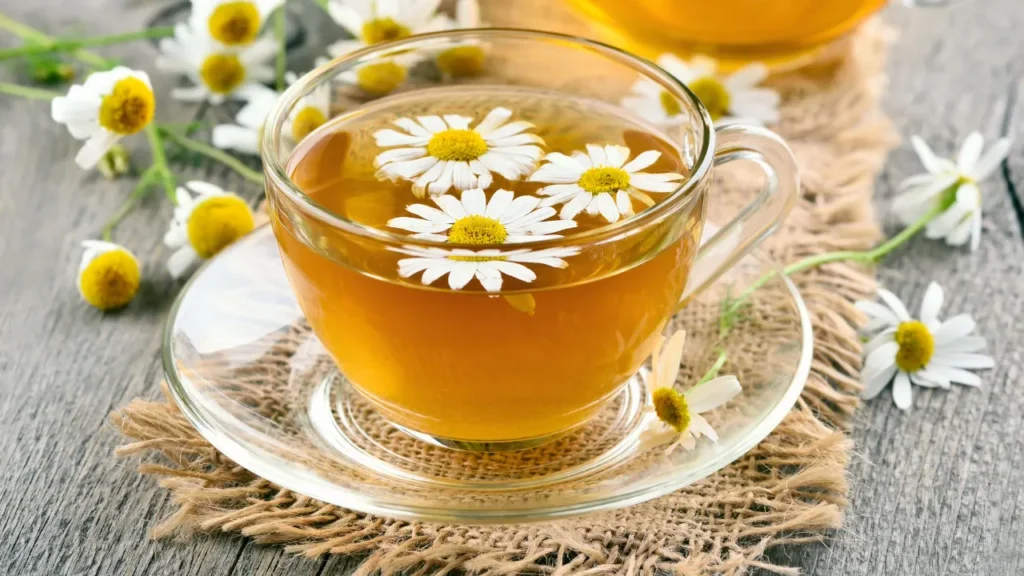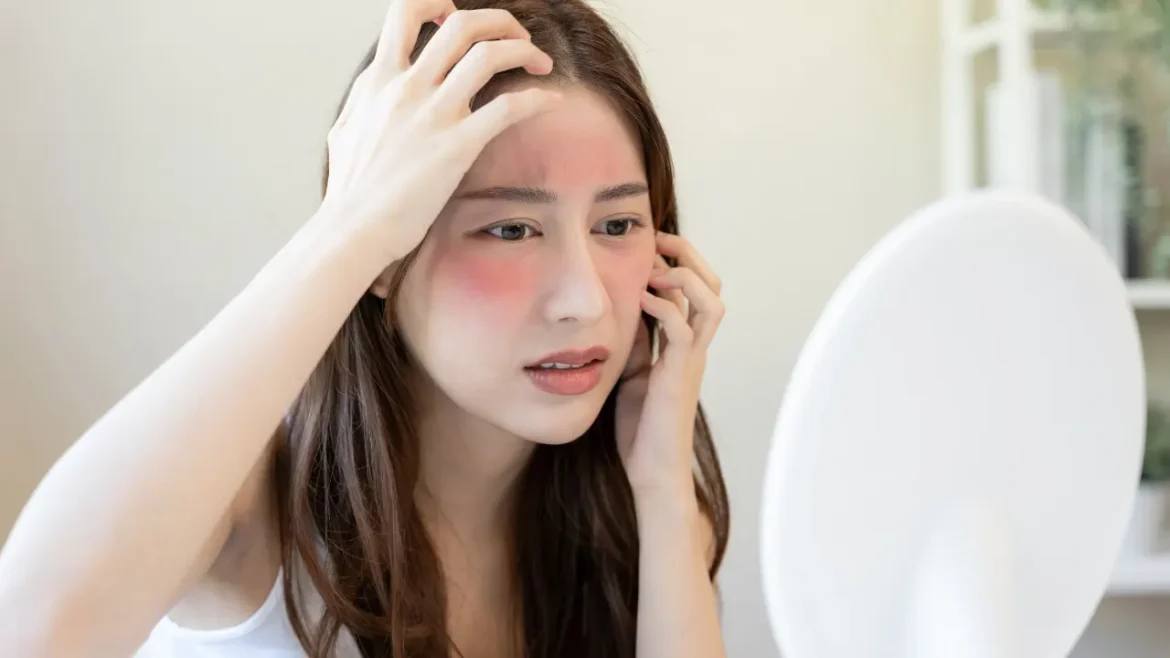Description
Rosacea constitutes a common dermatological illness marked by papules and pustules that occasionally comes along with chronic facial redness, flushing, and visible blood vessels. Fair-skinned people are primarily affected, and maturity is often when symptoms first appear. Although the precise etiology of rosacea is still unknown, a number of factors, such as immunological dysfunction, vascular abnormalities, genetic predisposition, and environmental triggers, are likely to have a role in the disease’s occurrence.
The four sub categories of rosacea include phymatous rosacea, papulopustular rosacea, erythematotelangiectatic rosacea, and ocular rosacea. While papulopustular rosacea manifests with pustules, papules, and facial redness, erythematotelangiectatic rosacea is marked by facial redness alongside visible blood vessels. Ocular rosacea impacts the eyes, creating redness, dryness, and irritation. Phymatous rosacea causes skin thickness and enlargement, most frequently on the nose.
You May Also Like:
IS DR MERCOLA KRILL OIL TRULY A GREAT SOURCE OF DAILY OMEGA-3S?
NATUREMYST KRILL OIL: A REVIEW OF THE FACTS ABOUT THIS LEADING OMEGA-3 PRODUCT
Rosacea: Description, Causes, And Treatment Protocol is an original (HealthXWire) article.
Possible Causes
It is still unclear what causes rosacea specifically. The onset of this persistent skin disorder, however, has been linked to numerous conditions. These potential causes include: –
Immune System Dysregulation: The occurrence of rosacea is believed to be influenced by immune system dysfunction. The defining signs of rosacea, including face redness and inflammation, are thought to be brought on by an unwarranted immune reaction in the skin.
Genetic Predisposition: According to studies, those who have rosacea in their family are more likely to get the condition themselves. The vulnerability to rosacea may be influenced by certain genetic variants and patterns of gene expression.
Vascular Abnormalities: The skin’s blood vessels enlarge and become more visible when someone has rosacea. The pathophysiology of rosacea is thought to entail vascular abnormalities, including aberrant blood vessel anatomy or function. These anomalies might be responsible for the flushing, lingering redness, and obvious blood vessels seen in affected people.
Demodex Mites: Small parasites called Demodex mites live on the skin inherently. It has been proposed that the emergence of rosacea can be linked to an overabundance or an inappropriate immunological reaction to these mites. Demodex mites’ precise contribution to the pathophysiology of rosacea is still being researched.
Microbial Factors: Some microorganisms, including bacteria and fungi, have been suggested to play a role in rosacea. The illness may develop or worsen because of an imbalance within the skin’s microbiota or an inappropriate immunological response to some particular bacteria. To fully comprehend the contribution of microbial elements to rosacea, more study is necessary.
Environmental Triggers: Environmental triggers include being exposed to ultraviolet (UV) rays and sunlight, extremely high or low temperatures, humidity, wind, and particular foods and beverages.
Exacerbating and Mitigating Factors
In the onset and treatment of rosacea, aggravating and moderating variables both play a significant role. Finding and preventing triggers may minimize flare-ups and enhance overall symptom management. Following are some typical aggravating and reducing elements related to rosacea: –
The exacerbating factors include the following: –
Extreme Temperatures: Rosacea symptoms may develop in hot and cold environments. Flushing and increased redness are brought on by heat, steam rooms, saunas, and hot baths. Dryness, irritability, and flare-ups may result from the wind, cold, and reduced humidity.
UV Exposure from Sunlight: UV light can widen blood vessels, which increases sensitivity and increases redness. Wearing hats, sunglasses, and sunscreen with a broad spectrum is crucial for shielding the skin against the sun.
Spicy Foods: Hot peppers and other spicy foods can dilate blood vessels and produce flushing, which makes rosacea sufferers more sensitive and red. It is advised to recognize spicy meals as triggers and minimize their intake.
Alcohol Consumption: Rosacea flare-ups can frequently be brought on by alcohol, especially red wine and strong liquor. Alcohol can cause facial flushing and a reddish flush on the face by widening blood vessels and increasing blood circulation to one’s skin. Symptom management may be aided by restricting or preventing alcohol consumption.
Emotional Factors and Stress: Some people may experience rosacea flare-ups due to anxiety, emotional stress, and strong emotions. It may be possible to manage symptoms by using stress management approaches like mindfulness training, relaxation techniques, and support groups.
Hot Beverages: Tea, coffee, and hot chocolate are among the hot drinks that can cause flushing and make rosacea symptoms worse. The effect on the skin may be reduced by choosing cooler or lukewarm substitutes.
The mitigating factors include the following: –
Avoiding Known Triggers: Rosacea symptoms can be greatly reduced by recognizing and preventing personal triggers. Identifying patterns and making appropriate adjustments can be aided by maintaining a diary to note triggers and their impact on the skin.
Protecting the Skin: It is critical to protect the skin against extreme weather, which includes chilly winds or intense heat. To protect your face from the weather, put on the appropriate gear, such as caps and scarves.
Gentle Skincare Routine: Rosacea sufferers must develop a mild skincare routine. People should utilize moisturizers and cleansers made especially for sensitive skin that are gentle, non-irritating, and non-abrasive.
Skincare Product Selection: People should use soft, non-comedogenic skincare items free from fragrance and stay away from items that include abrasive chemicals, alcohol, or scents because they might irritate one’s skin and make rosacea symptoms severe.
Stress Management: Rosacea symptoms may be better controlled by reducing stress through relaxation exercises, physical activity, counseling, or other stress mitigation treatments. The effects of emotional stressors on the skin might be reduced with the aid of stress management practices.

Standard Treatment Protocol
Rosacea is typically treated with a regimen designed to manage symptoms, lessen inflammation, and enhance skin quality. Along with the integration of oral and topical drugs, it often entails making the following changes to one’s way of life: –
Topical Medications: These include: –
- Azelaic Acid
Having anti-inflammatory and antibacterial qualities, this topical medicine aids in reducing inflammation and preventing lesions that resemble acne.
- Metronidazole
This anti-inflammatory gel or lotion helps manage rosacea-related redness and irritation.
Through the constriction of blood vessels, this medicine, a topical vasoconstrictor, minimizes facial redness.
- Ivermectin
Demodex mites are the focus of this treatment since they are thought to be a factor in rosacea. Ivermectin lessens signs and symptoms and decreases inflammation.
Oral Medications: These include: –
- Oral Antibiotics
Oral antibiotics like doxycycline, minocycline, and tetracycline are frequently prescribed to treat rosacea-related bacterial overgrowth and inflammation while also reducing redness.
Only serious instances of rosacea that have failed other therapies should be treated with this oral retinoid. It aids in symptom management and inflammation reduction, but due to potential adverse effects, it necessitates strict monitoring.
Lifestyle Modifications: These include: –
- Sun Protection
Applying a high SPF broad-spectrum sunscreen is necessary to shield the skin from ultraviolet (UV) radiation and sunlight. When outside, individuals should use protective gear, a hat with a wide brim, and sunglasses.
- Skincare
Rosacea sufferers must use gentle skincare techniques and avoid using abrasive items or harsh cleanses that could make the issue worse.
Trigger Management: Rosacea causes should be recognized and avoided, including sunshine, heat, spicy meals, hot beverages, alcohol, and stress.


Treatment Options
There are numerous adjunct treatment alternatives available in addition to the normal treatment plan that could supplement traditional therapies and possibly increase their effectiveness. These complementary therapies comprise: –
Nutritional Supplements: These include: –
- Antioxidants
Antioxidants like vitamin E and vitamin C can decrease inflammation and oxidative stress in one’s skin.
- Omega-3 Fatty Acids
Omega-3 fatty acids, which are present within fish oil supplements, offer anti-inflammatory effects that may help lessen inflammation related to rosacea.
Natural Remedies: These include: –
- Aloe Vera
Aloe vera gel contains calming and anti-inflammatory qualities. Natural aloe vera gel applied to the affected regions may offer momentary relief from irritation and redness.
- Chamomile
An anti-inflammatory and relaxing effect of chamomile. Rosacea symptoms could be relieved by topical application or by utilizing chamomile tea compresses.
- Green Tea Extract
Polyphenols found in green tea have anti-inflammatory and antioxidant properties. Green tea can help lessen rosacea-related inflammation whether applied topically or consumed.
- Licorice Root Extract
An anti-inflammatory and relaxing agent, licorice root extract. When used topically, it might reduce redness and inflammation.
However, it is crucial to remember that while many complementary treatments appear promising, individual results may differ. Before adding any adjunct treatments or supplements to the treatment plan, it is essential to speak with a medical expert, like a dermatologist. They can make specific recommendations and guarantee the security and effectiveness of these therapies in each case.


Conclusion
Rosacea is a chronic skin condition that can appear as papules and pustules along with facial redness and severe flushing. The specific cause for rosacea is unclear, however, this condition has been closely linked to the dysregulation of the immune system and people with certain genetic predispositions are more vulnerable to rosacea. Dermatologists commonly prescribe topical treatments like azelaic acid, metronidazole, oral antibiotics like isotretinoin, and in some cases, laser therapy to control the conditions associated with rosacea.
Additionally, practicing good skincare habits with good sun protection and avoiding known triggers can help prevent flare-ups. Close collaboration between patients and healthcare providers is essential in tailoring treatment plans and addressing individual needs. Besides medical treatments and good habits, taking nutritional supplements such as omega-fatty acids, chamomile, etc has improved the efficacy of the treatment plan.


Additional resources for further reference
https://www.aad.org/public/diseases/rosacea/what-is/causes
https://my.clevelandclinic.org/health/diseases/12174-rosacea
Important Note: The information contained in this article is for general informational purposes only, and should not be construed as health or medical advice, nor is it intended to diagnose, prevent, treat, or cure any disease or health condition. Before embarking on any diet, fitness regimen, or program of nutritional supplementation, it is advisable to consult your healthcare professional in order to determine its safety and probable efficacy in terms of your individual state of health.
Regarding Nutritional Supplements Or Other Non-Prescription Health Products: If any nutritional supplements or other non-prescription health products are mentioned in the foregoing article, any claims or statements made about them have not been evaluated by the U.S. Food and Drug Administration, and such nutritional supplements or other health products are not intended to diagnose, treat, cure, or prevent any disease.
Table of Contents


